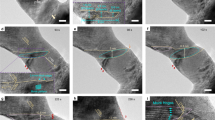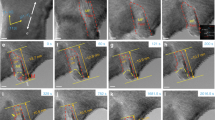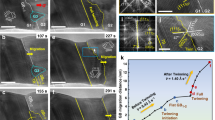Abstract
Twinning is a fundamental deformation mode that competes against dislocation slip in crystalline solids. In metallic nanostructures, plastic deformation requires higher stresses than those needed in their bulk counterparts, resulting in the ‘smaller is stronger’ phenomenon. Such high stresses are thought to favour twinning over dislocation slip. Deformation twinning has been well documented in face-centred cubic (FCC) nanoscale crystals. However, it remains unexplored in body-centred cubic (BCC) nanoscale crystals. Here, by using in situ high-resolution transmission electron microscopy and atomistic simulations, we show that twinning is the dominant deformation mechanism in nanoscale crystals of BCC tungsten. Such deformation twinning is pseudoelastic, manifested through reversible detwinning during unloading. We find that the competition between twinning and dislocation slip can be mediated by loading orientation, which is attributed to the competing nucleation mechanism of defects in nanoscale BCC crystals. Our work provides direct observations of deformation twinning as well as new insights into the deformation mechanism in BCC nanostructures.
This is a preview of subscription content, access via your institution
Access options
Subscribe to this journal
Receive 12 print issues and online access
$259.00 per year
only $21.58 per issue
Buy this article
- Purchase on Springer Link
- Instant access to full article PDF
Prices may be subject to local taxes which are calculated during checkout
 compression.
compression.



Similar content being viewed by others
References
Zhu, T. & Li, J. Ultra-strength materials. Prog. Mater. Sci. 55, 710–757 (2010).
Greer, J. R. & DeHosson, J. T. M. Plasticity in small-sized metallic systems: Intrinsic versus extrinsic size effect. Prog. Mater. Sci. 56, 654–724 (2011).
Zhu, Y. T., Liao, X. Z. & Wu, X. L. Deformation twinning in nanocrystalline materials. Prog. Mater. Sci. 57, 1–62 (2012).
Lu, K., Lu, L. & Suresh, S. Strengthening materials by engineering coherent internal boundaries at the nanoscale. Science 324, 349–352 (2009).
Uchic, M. D., Dimiduk, D. M., Florando, J. N. & Nix, W. D. Sample dimensions influence strength and crystal plasticity. Science 305, 986–989 (2004).
Shan, Z. W., Mishra, R. K., Syed Asif, S. A., Warren, O. L. & Minor, A. M. Mechanical annealing and source-limited deformation in submicrometre-diameter Ni crystals. Nature Mater. 7, 115–119 (2007).
Yu, Q. et al. Strong crystal size effect on deformation twinning. Nature 463, 335–338 (2010).
Wang, J. W. et al. Atomic-scale dynamic process of deformation-induced stacking fault tetrahedra in gold nanocrystals. Nature Commun. 4, 2340 (2013).
Wang, J. et al. Near-ideal theoretical strength in gold nanowires containing angstrom scale twins. Nature Commun. 4, 1742 (2013).
Marichal, C., Van Swygenhoven, H., Van Petegem, S. & Borca, C. {110} Slip with {112} slip traces in bcc tungsten. Sci. Rep. 3, 2547 (2013).
Li, L. & Ortiz, C. Pervasive nanoscale deformation twinning as a catalyst for efficient energy dissipation in a bioceramic armour. Nature Mater. 13, 501–507 (2014).
Huang, L. et al. A new regime for mechanical annealing and strong sample-size strengthening in body centred cubic molybdenum. Nature Commun. 2, 547 (2011).
Greer, J. & Nix, W. Nanoscale gold pillars strengthened through dislocation starvation. Phys. Rev. B 73, 245410 (2006).
Sedlmayr, A. et al. Existence of two twinning-mediated plastic deformation modes in Au nanowhiskers. Acta Mater. 60, 3985–3993 (2012).
Yue, Y. et al. Quantitative evidence of crossover toward partial dislocation mediated plasticity in copper single crystalline nanowires. Nano Lett. 12, 4045–4049 (2012).
Seo, J-H. et al. Superplastic deformation of defect-free Au nanowires via coherent twin propagation. Nano Lett. 11, 3499–3502 (2011).
Sun, J. et al. Liquid-like pseudoelasticity of sub-10-nm crystalline silver particles. Nature Mater. 13, 1007–1012 (2014).
Lita, A. E. et al. Tuning of tungsten thin film superconducting transition temperature for fabrication of photon number resolving detectors. IEEE Trans. Appl. Supercond. 15, 3528–3531 (2005).
Lee, Y-H. et al. Tungsten nanowires and their field electron emission properties. Appl. Phys. Lett. 81, 745–747 (2002).
Zhang, Y. et al. Automated nanomanipulation for nanodevice construction. Nanotechnology 23, 065304 (2012).
Swygenhoven, H. V., Derlet, P. M. & Frøseth, A. G. Stacking fault energies and slip in nanocrystalline metals. Nature Mater. 3, 399–403 (2004).
Warner, D. H., Curtin, W. A. & Qu, S. Rate dependence of crack-tip processes predicts twinning trends in f.c.c. metals. Nature Mater. 6, 876–881 (2007).
Yamakov, V. I. & Glaessgen, E. H. Nanoscale fracture: To twin or not to twin. Nature Mater. 6, 795–796 (2007).
Yu, Q. et al. The nanostructured origin of deformation twinning. Nano Lett. 12, 887–892 (2012).
Christian, J. W. & Mahajan, S. Deformation twinning. Prog. Mater. Sci. 39, 1–157 (1995).
Argon, A. S. & Maloof, S. R. Fracture of tungsten single crystals at low temperatures. Acta Metall. 14, 1463–1468 (1966).
Chen, C. Q., Florando, J. N., Kumar, M., Ramesh, K. T. & Hemker, K. J. Incipient deformation twinning in dynamically sheared bcc tantalum. Acta Mater. 69, 114–125 (2014).
Kim, J-Y., Jang, D. & Greer, J. R. Tensile and compressive behavior of tungsten, molybdenum, tantalum and niobium at the nanoscale. Acta Mater. 58, 2355–2363 (2010).
Han, M. S. et al. Critical-temperature/Peierls-stress dependent size effects in body centered cubic nanopillars. Appl. Phys. Lett. 102, 041910 (2013).
Xie, K. Y. et al. The effect of pre-existing defects on the strength and deformation behavior of α-Fe nanopillars. Acta Mater. 61, 439–452 (2013).
Marichal, C. et al. Origin of anomalous slip in tungsten. Phys. Rev. Lett. 113, 025501 (2014).
Chisholm, C. et al. Dislocation starvation and exhaustion hardening in Mo alloy nanofibers. Acta Mater. 60, 2258–2264 (2012).
Bei, H., Shim, S., Pharr, G. M. & George, E. P. Effects of pre-strain on the compressive stress–strain response of Mo-alloy single-crystal micropillars. Acta Mater. 56, 4762–4770 (2008).
Schneider, A. et al. Correlation between critical temperature and strength of small-scale bcc pillars. Phys. Rev. Lett. 103, 105501 (2009).
Wang, Y. M. et al. Deformation twinning during nanoindentation of nanocrystalline Ta. Appl. Phys. Lett. 86, 101915 (2005).
Duesbery, M. S. & Vitek, V. Plastic anisotropy in b.c.c. transition metals. Acta Mater. 46, 1481–1492 (1998).
Narayanan, S., McDowell, D. L. & Zhu, T. Crystal plasticity model for BCC iron atomistically informed by kinetics of correlated kinkpair nucleation on screw dislocation. J. Mech. Phys. Solids 65, 54–68 (2014).
Weinberger, C. R. & Cai, W. Surface-controlled dislocation multiplication in metal micropillars. Proc. Natl Acad. Sci. USA 105, 14304–14307 (2008).
Gumbsch, P., Riedle, J., Hartmaier, A. & Fischmeister, H. F. Controlling factors for the brittle-to-ductile transition in tungsten single crystals. Science 282, 1293–1295 (1998).
Brunner, D. Comparison of flow-stress measurements on high-purity tungsten single crystals with the kink-pair theory. Mater. Trans. 41, 152–160 (2000).
Weinberger, C. R., Boyce, B. L. & Battaile, C. C. Slip planes in bcc transition metals. Int. Mater. Rev. 58, 296–314 (2013).
Srivastava, K., Weygand, D. & Gumbsch, P. Dislocation junctions as indicators of elementary slip planes in body-centered cubic metals. J. Mater. Sci. 49, 7333–7337 (2014).
Caillard, D. Kinetics of dislocations in pure Fe. Part I. In situ straining experiments at room temperature. Acta Mater. 58, 3493–3503 (2010).
Ogata, S., Li, J. & Yip, S. Energy landscape of deformation twinning in bcc and fcc metals. Phys. Rev. B 71, 224102 (2005).
Greer, J. R., Weinberger, C. R. & Cai, W. Comparing the strength of f.c.c. and b.c.c. sub-micrometer pillars: Compression experiments and dislocation dynamics simulations. Mater. Sci. Eng. A 493, 21–25 (2008).
Juan, J. S., Nó, M. L. & Schuh, C. A. Nanoscale shape-memory alloys for ultrahigh mechanical damping. Nature Nanotechnol. 4, 415–419 (2009).
Lai, A., Du, Z. H., Gan, C. L. & Schuh, C. A. Shape memory and superelastic ceramics at small scales. Science 341, 1505–1508 (2013).
Li, S. et al. High-efficiency mechanical energy storage and retrieval using interfaces in nanowires. Nano Lett. 10, 1774–1779 (2010).
Zhong, L., Wang, J., Sheng, H., Zhang, Z. & Mao, S. X. Formation of monatomic metallic glasses through ultrafast liquid quenching. Nature 512, 177–180 (2014).
Acknowledgements
S.X.M. acknowledges the support from NSF CMMI 08 010934 through University of Pittsburgh and Sandia National Lab. T.Z. acknowledges the support from DOE NEUP Grant DE-AC07-05ID14517, NSF grant DMR-1410331, and HPC resources in CAS Shenyang Supercomputing Centre. This work was performed, in part, at the Center for Integrated Nanotechnologies, a US Department of Energy, Office of Basic Energy Sciences user facility. This research was supported in part by an appointment to the Sandia National Laboratories Truman Fellowship in National Security Science and Engineering, sponsored by Sandia Corporation (a wholly owned subsidiary of Lockheed Martin Corporation) as Operator of Sandia National Laboratories under its US Department of Energy Contract No. DE-AC04-94AL85000. The authors are grateful to W. Cai of Stanford University, J. Li of Massachusetts Institute of Technology and J. Y. Huang for stimulating discussions.
Author information
Authors and Affiliations
Contributions
J.W. designed and conducted experiments, analysed data and wrote the paper under the direction of S.X.M. C.R.W., Z.Zeng and T.Z. performed computer simulations. T.Z., C.R.W. and S.X.M. contributed to data analysis and revised the paper. All the authors contributed to the discussion.
Corresponding authors
Ethics declarations
Competing interests
The authors declare no competing financial interests.
Supplementary information
Supplementary Information
Supplementary Information (PDF 3039 kb)
Supplementary Information
Supplementary Movie 1 (MOV 4845 kb)
Supplementary Information
Supplementary Movie 2 (MOV 1446 kb)
Supplementary Information
Supplementary Movie 3 (MOV 4433 kb)
Supplementary Information
Supplementary Movie 4 (MOV 13471 kb)
Supplementary Information
Supplementary Movie 5 (MOV 599 kb)
Rights and permissions
About this article
Cite this article
Wang, J., Zeng, Z., Weinberger, C. et al. In situ atomic-scale observation of twinning-dominated deformation in nanoscale body-centred cubic tungsten. Nature Mater 14, 594–600 (2015). https://doi.org/10.1038/nmat4228
Received:
Accepted:
Published:
Issue Date:
DOI: https://doi.org/10.1038/nmat4228
This article is cited by
-
Atomic-scale observation of nucleation- and growth-controlled deformation twinning in body-centered cubic nanocrystals
Nature Communications (2024)
-
Resolving complex intralayer transition motifs in high-Ni-content layered cathode materials for lithium-ion batteries
Nature Materials (2023)
-
Nanoscale ductile fracture and associated atomistic mechanisms in a body-centered cubic refractory metal
Nature Communications (2023)
-
Chemical inhomogeneity–induced profuse nanotwinning and phase transformation in AuCu nanowires
Nature Communications (2023)
-
Revealing interface-assisted plastic anisotropy via in situ transmission electron microscopy tension of lamellar TiAl
Science China Materials (2023)



